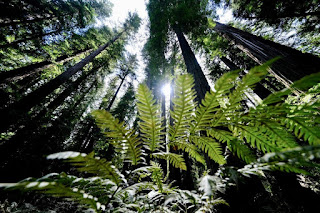In nature there are ecological processes that underpin our lives. Damage to the ecological process will endanger life on Our Earth. Energy for the ecological process is obtained from the sun. Below are described some of the most important processes.
• Photosynthesis
Photosynthesis is an essential process for maintaining survival on earth. Photosynthesis is mainly carried out by green plants. In this process the sun's energy is converted into chemical energy contained in plant organic matter. This energy is used for the life of other living things that cannot carry out photosynthesis, including humans, animals and microorganisms
Photosynthesis also produces oxygen gas (O2). Oxygen gas is essential for breathing many types of creatures, including humans. Without oxygen in a short time humans will die.
Life in water is also supported by photosynthesis. Photosynthesis is carried out by a ton bank of single-celled plants that float in water. Plankton is a fish food and oxygen producer.
From oxygen in the atmosphere Ozone gas is formed. Ozone gas which is contained in a high layer of air, protects the earth from short-wave sunlight, including ultraviolet rays, ultraviolet rays are very dangerous for living things. Therefore the destruction of the ozone layer will cause the extinction of life on Earth. Only those who live in deep water remain protected from ultraviolet rays by a thick layer of water. This is life on earth before photosynthesis, about 4 billion years ago.
Considering the importance of photosynthesis, we must maintain that in the ecological process there remain enough green plants, including forests, shrubs and grasslands.
• Nitrogen inhibition
Nitrogen is an essential element for the life of living things. The air contains about 80% nitrogen. But the abundant nitrogen gas is not useful for humans and most other living things. Fortunately on earth there are living things that can tether nitrogen from the air. Living creatures are part of their lives free. Some live in symbiosis with other living things.
Living things free air nitrogen fixing bacteria and blue green algae. Examples of bacteria are azotobacter and anabaena algae examples. Some live in dry land and some in wet soil. In rice fields, for example, air nitrogen tethering can reach 80 kg N per hectare per season. this amount is equivalent to 175 kg of urea, a considerable amount.
The energy for tethering is obtained from organic matter found in the environment of living things through metabolic processes
Other classes of living creatures that are nitrogen-fixing air are living in symbiosis with other living creatures. Living in symbiosis means living together for mutual benefit. The best known is the rhizobium bacteria that live in nodules of the roots of legumes. The bacteria get food from photosynthetic legumes. Some of the energy in food is used to tether air nitrogen. Air nitrogen is partly beneficial for legumes.
Air nitrogen tethering plays an important role in maintaining soil and water fertility. Examples of living things nitrogen-fixing air, forests and grasslands will languish or even die. We will also need a lot of N fertilizer, for example urea. For fertilizer production, a very large amount of energy is needed. Damage to the air nitrogen tethering ability will also teach the nitrogen cycle. Therefore the environment's ability to fix nitrogen must be maintained and maintained. Excessive fertilization inhibits the activity of air nitrogen-fixing creatures. Pollution can also kill or disrupt the life of the creature, so that the ability to inhibit air nitrogen decreases
• Population control
Pest and disease control by predators greatly benefits us. First, because control occurs automatically with a dynamic balance. Second, we no longer need to spend a little money and energy to control it. Therefore the food chain which is the basis of the ability of the environment to carry out the function of controlling pests and diseases must be maintained. For example, excessive use of pest poisoning, industrial and transport pollution can damage the ability of the environment to control pests and diseases.



No comments:
Post a Comment